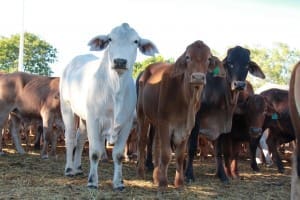WHERE northern live cattle export prices will settle is anyone’s guess after the roller coaster ride of recent weeks.
Only a month ago prices were trading in the $3.85 range, with a handful selling up to $4/kg at the height of the Northern Territory wet season.
Today sales are being contracted as low as $2.60/kg.
The industry is used to price falls in April as the first dry season musters push an influx of new supply onto the market.
But this year uncertainty around COVID-19 and its impact on demand and logistics in key South East Asian markets has added further weight to traditional downward market pressure.
Indonesian feedlots are currently filled with expensive cattle, many of which were purchased in the $3.40-$3.80 range. Fasting for the month long Ramadan begins today. In normal years feedlots would see their highest volume and highest margin sales beginning during this fasting month, rising to a crescendo with the Lebaran feasting festival at the end.
But at a time when feedlot businesses would normally be capitalising on strong demand, sales are likely to be subdued due to the impacts of COVID-19 disruptions on travel movements for family and cultural celebrations and restrictions on street food sales.
A plummeting Indonesian Rupiah which has reduced the buying power of Indonesian feedlots, and reports of some shipments being cancelled have added to producer nervousness about the market in recent weeks.
It is difficult to know if the sudden fall from around $3.40/kg to $2.60/kg is a fair reflection of market conditions or whether it was the act of such a low price being offered in the first place that precipitated the dramatic market drop.
One experienced industry stakeholder told the story of how, at times when cattle prices got too expensive, a wily livestock manager for a major processor would sometimes throw out an incredibly low price, knowing it would entice some people to panic sell and, hence, help to set a new, lower market level.
Whether they were trying the same approach isn’t clear, but an exporter threw out $2.60/kg offer a few weeks ago, as prices were still in the mid-$3/kg range and cattle were difficult to buy, and as concerns around COVID-19’s potential impact on demand were mounting.
At the same time some Queensland feedlots also stopped offering quotes. After having traded well into the $4/kg range in February, Queensland feeder prices are also said to have dropped to the $3/kg mark and even lower now.
While the $2.60/kg offer for live export steers failed to attract interest at first, in the past week it has been snapped up by some producers, which has set a new lower level for the market.
Where the ship will steady remains to be seen.
There are still a lot of ships being loaded for Indonesia and Vietnam for the remainder of April and May.
Indonesian’s trade ministry says it is working to ensure the distribution of beef remains smooth amid the COVID-19 outbreak by partnering with ride-hailing company Gojek, which has over 1 million drivers nationwide, to help deliver food staples including beef to people staying at home in compliance with physical distancing measures.
The Indonesian Government also yesterday banned ‘Mudik’, the annual exodus of some 20 million people from Greater Jakarta, to their hometowns for Lebaran, to prevent the spread of COVID-19 . More people in cities may mean more city food, or more imported beef, being consumed, one industry stakeholder said.
Vietnam moved at roughly the same time and speed as New Zealand to lock their country down, closing food service, takeaway and dining out options. Its feedlots are also carrying expensive cattle that are difficult to move, but there are now signs of the market starting to open again as Vietnam ‘comes out other end’. Vietnam has not had a single death from COVID-19 and is now being praised for its rapid and proactive approach to managing the threat.
Some large scale producers have indicated to Beef Central in recent days they are still contracting cattle in the $2.80 to $3.00 range.
“As much as $4 was short lived, I think $2.60 will also be short lived and we will be back at $2.80 to $3 soon,” was how one key trade stakeholder answered the question of where prices will move next.




HAVE YOUR SAY